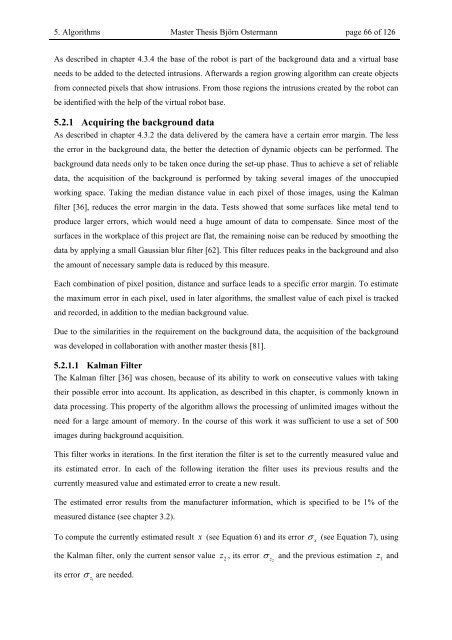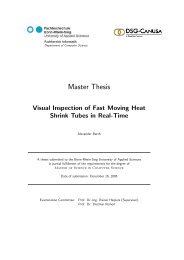Master Thesis - Hochschule Bonn-Rhein-Sieg
Master Thesis - Hochschule Bonn-Rhein-Sieg
Master Thesis - Hochschule Bonn-Rhein-Sieg
You also want an ePaper? Increase the reach of your titles
YUMPU automatically turns print PDFs into web optimized ePapers that Google loves.
5. Algorithms <strong>Master</strong> <strong>Thesis</strong> Björn Ostermann page 66 of 126<br />
As described in chapter 4.3.4 the base of the robot is part of the background data and a virtual base<br />
needs to be added to the detected intrusions. Afterwards a region growing algorithm can create objects<br />
from connected pixels that show intrusions. From those regions the intrusions created by the robot can<br />
be identified with the help of the virtual robot base.<br />
5.2.1 Acquiring the background data<br />
As described in chapter 4.3.2 the data delivered by the camera have a certain error margin. The less<br />
the error in the background data, the better the detection of dynamic objects can be performed. The<br />
background data needs only to be taken once during the set-up phase. Thus to achieve a set of reliable<br />
data, the acquisition of the background is performed by taking several images of the unoccupied<br />
working space. Taking the median distance value in each pixel of those images, using the Kalman<br />
filter [36], reduces the error margin in the data. Tests showed that some surfaces like metal tend to<br />
produce larger errors, which would need a huge amount of data to compensate. Since most of the<br />
surfaces in the workplace of this project are flat, the remaining noise can be reduced by smoothing the<br />
data by applying a small Gaussian blur filter [62]. This filter reduces peaks in the background and also<br />
the amount of necessary sample data is reduced by this measure.<br />
Each combination of pixel position, distance and surface leads to a specific error margin. To estimate<br />
the maximum error in each pixel, used in later algorithms, the smallest value of each pixel is tracked<br />
and recorded, in addition to the median background value.<br />
Due to the similarities in the requirement on the background data, the acquisition of the background<br />
was developed in collaboration with another master thesis [81].<br />
5.2.1.1 Kalman Filter<br />
The Kalman filter [36] was chosen, because of its ability to work on consecutive values with taking<br />
their possible error into account. Its application, as described in this chapter, is commonly known in<br />
data processing. This property of the algorithm allows the processing of unlimited images without the<br />
need for a large amount of memory. In the course of this work it was sufficient to use a set of 500<br />
images during background acquisition.<br />
This filter works in iterations. In the first iteration the filter is set to the currently measured value and<br />
its estimated error. In each of the following iteration the filter uses its previous results and the<br />
currently measured value and estimated error to create a new result.<br />
The estimated error results from the manufacturer information, which is specified to be 1% of the<br />
measured distance (see chapter 3.2).<br />
To compute the currently estimated result x (see Equation 6) and its error � x (see Equation 7), using<br />
the Kalman filter, only the current sensor value z 2 , its error � z and the previous estimation z 2<br />
1 and<br />
its error<br />
� z are needed.<br />
1














